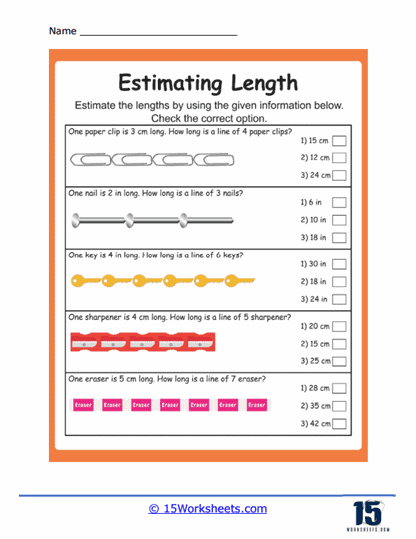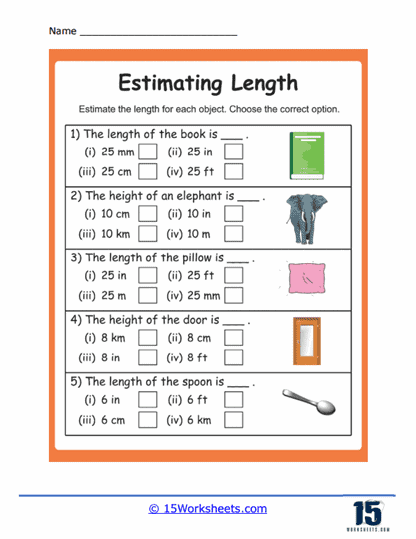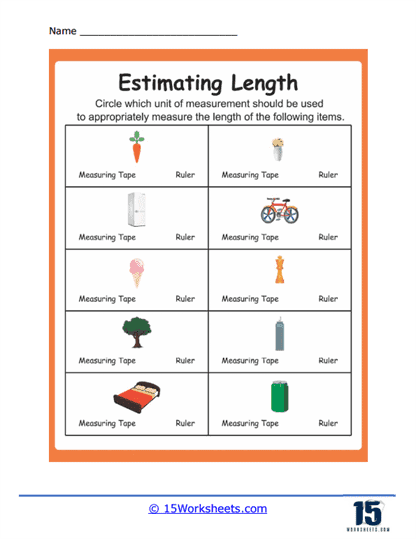Estimating Length Worksheets
About These 15 Worksheets
Estimation is a valuable skill in everyday life and academic disciplines. Whether you’re trying to judge the size of a space for furniture or determining the distance between two points on a map, the ability to estimate with reasonable accuracy is invaluable. These worksheets were designed to teach and practice the skill of approximating the length or distance of objects and spaces without exact measurement tools.
This collection of worksheets focus on helping students develop the ability to judge the length or distance of objects by approximation. While exact measurements are crucial in many scenarios, the skill of estimation allows one to make swift, practical decisions or judgments when precise tools might not be available. These worksheets provide exercises that challenge students to use reference points, prior knowledge, and intuitive understanding to gauge lengths and distances.
A Look At These Worksheets
Estimating length may not sound like the most thrilling adventure, but these worksheets turn measurement into something like a heroic journey-complete with purple string, mysterious pencils, and the philosophical question: “How long is long, really?” At the heart of it all, students begin their quest with the basics in “Longer Objects” and “Longer Shapes“, where they must compare items like they’re ancient scholars debating whose toga drapes more regally. These activities ease students into the noble art of visual approximation, prompting them to sharpen their spatial reasoning skills without once reaching for a ruler.
From there, students are whisked into the chaotic world of human error and educated guesses in “Best Estimate“, “Better Estimates“, and “Likely Estimates.” Here, they must navigate the foggy realm of maybe-ish and probably-close, where answers aren’t exact, but they sure feel right. These worksheets encourage students to flex their math intuition like it’s a sixth sense. They’re not just learning to measure-they’re learning to trust themselves in a universe where not everything can (or should) be perfectly calculated. Somewhere between logic and gut feeling lies the perfect estimate, and these worksheets are the dojo for that inner ninja.
When students think they’ve got the hang of it, they’re thrown into the philosophical spiral of “Which Object” and “Appropriate Measures.” Is a bus measured in millimeters? Is a toothpick best represented in kilometers? These are not mere questions-they’re riddles of the metaphysical measurement world. These worksheets force young minds to confront the absurdity of mismatched units and to humbly accept that size does matter-but context matters even more.
Then come the hands-on gladiator matches with actual rulers in “Using Rulers in Estimates“, “In Centimeters“, and “Measures of Length.” Here, students stop daydreaming and start doing, using tools of the trade to test their estimation theories. Like scientific pioneers, they measure and compare, slowly discovering whether their mental guesses align with cold, hard plastic reality. It’s humbling. It’s enlightening. It may even involve sighing dramatically when you learn your “15 cm” guess was actually 22 cm. But it’s progress.
For the true connoisseurs of measurement drama, there are the oddly poetic worksheet titles: “Purple String Lengths,” “How Many Pencils,” “Transferring Length,” and “Relative Length.” These sound more like abstract art pieces than math practice, but they hit students with beautifully messy, real-world applications. How many pencils does it take to match a desk’s width? Can the length of a mysterious purple string help us solve the mysteries of the universe-or at least the worksheet? These exercises push students into thinking creatively about length, pushing boundaries (and measuring them). Estimating length, it turns out, is a doorway to wonder, wisdom, and the whimsical realization that rulers are just approximations too, if you squint hard enough.
The Significance of Estimating Length
Building Practical Skills – Estimation is a practical skill. Whether one is doing a quick calculation in one’s head while shopping, crafting, or trying to judge the size of a space, estimation is often faster and more convenient than pulling out a measuring tool.
Laying Foundations for Higher Learning – In advanced studies, especially in subjects like physics, engineering, or architecture, estimation is a key skill. Professionals often make educated guesses before diving into detailed calculations.
Developing Spatial Awareness – Engaging with these worksheets helps students develop a better sense of space, size, and distance, which can aid in tasks ranging from art to sports to navigation.
Cultivating Critical Thinking – Estimation isn’t about guessing blindly. It’s about making an informed judgment based on available information, prior knowledge, and logical reasoning.
Encouraging Flexibility in Thinking – While exact measurements have their place, being overly reliant on them can limit one’s ability to adapt and make swift decisions. Estimation encourages a more flexible, adaptable approach to problem-solving.















